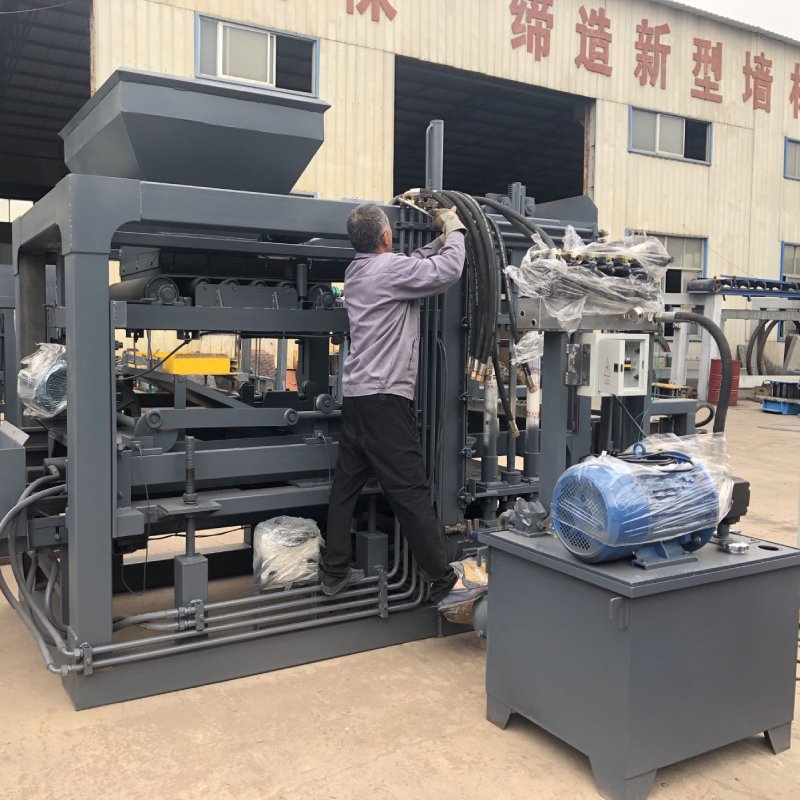
Image source :Aiweiblockmachine
Title: Revolutionizing Efficiency: Innovations in Material Handling Systems for Full-Automatic Lines
Introduction
Material handling is a critical aspect of full-automatic production lines, influencing efficiency, productivity, and overall operational success. As industries embrace automation and Industry 4.0 principles, innovations in material handling systems have become a key focus. This article explores cutting-edge advancements in material handling for full-automatic lines, shedding light on technologies that are reshaping the landscape of modern manufacturing.
1. **Autonomous Mobile Robots (AMRs)**
Autonomous Mobile Robots have emerged as game-changers in material handling for full-automatic lines. These robots navigate the production floor independently, transporting materials between workstations, storage areas, and production lines. Equipped with sensors and advanced navigation systems, AMRs can adapt to dynamic environments, avoiding obstacles and optimizing routes.
The use of AMRs enhances flexibility and responsiveness in material handling, as these robots can be easily reprogrammed to accommodate changes in production layouts or workflows. This innovation significantly reduces the need for fixed conveyors or manual transport, increasing overall agility in full-automatic production.
2. **Smart Conveyor Systems**
Traditional conveyor systems have evolved into smart conveyor systems, incorporating advanced sensors, connectivity, and automation capabilities. These systems are designed to optimize material flow, reduce bottlenecks, and enhance overall efficiency in full-automatic lines.
Smart conveyors equipped with sensors can detect the presence of materials, monitor their progress through the production line, and adjust speed or routing based on real-time conditions. Additionally, integration with data analytics platforms enables manufacturers to gather insights into material flow, identify potential optimization opportunities, and make data-driven decisions for continuous improvement.
3. **Automated Guided Vehicles (AGVs)**
Automated Guided Vehicles have undergone significant advancements, becoming integral components of material handling in full-automatic lines. These vehicles are equipped with guidance systems, such as laser or vision-based navigation, allowing them to navigate predefined paths autonomously.
AGVs are versatile and adaptable, capable of transporting materials, components, or finished products within a production facility. Integration with central control systems enables efficient coordination between AGVs, ensuring synchronized material flow and minimizing idle time. AGVs contribute to the optimization of logistics, especially in large-scale manufacturing environments.
4. **Robotics and Pick-and-Place Systems**
Robotic systems play a crucial role in material handling, especially in applications that involve picking, placing, and manipulating objects. Full-automatic lines are incorporating robotic arms equipped with advanced grippers and vision systems to handle materials with precision and efficiency.
Vision-guided robotic pick-and-place systems can identify and adapt to variations in material positioning, enabling the handling of diverse product types. The integration of robotics in material handling systems not only enhances speed and accuracy but also contributes to the overall flexibility of production lines.
5. **Automated Storage and Retrieval Systems (AS/RS)**
Automated Storage and Retrieval Systems have evolved to accommodate the demands of full-automatic lines. These systems utilize robotic technology to autonomously store and retrieve materials from designated storage locations. AS/RS systems are designed for high-density storage and quick access to materials, optimizing the use of available space.
In full-automatic production lines, AS/RS solutions contribute to efficient inventory management, reduce the need for manual handling, and ensure a seamless flow of materials to and from production workstations. The integration of AS/RS enhances storage capacity while minimizing the footprint within the manufacturing facility.
6. **Predictive Maintenance and Condition Monitoring**
Innovations in material handling systems extend beyond physical components to include predictive maintenance and condition monitoring. Advanced sensors embedded in conveyors, robots, and other handling equipment enable real-time monitoring of equipment health.
Predictive maintenance algorithms analyze data from sensors to predict potential issues before they lead to equipment failures. This proactive approach minimizes unplanned downtime, extends the lifespan of material handling systems, and contributes to the overall reliability of full-automatic production lines.
7. **Collaborative Robotics (Cobots)**
Collaborative robots, or cobots, are designed to work alongside human operators seamlessly. In material handling, cobots can be employed to assist with tasks such as loading and unloading materials, palletizing, or transporting items within the production facility.
Cobots enhance the flexibility of material handling systems by providing a collaborative and adaptive approach. They can be easily reprogrammed for different tasks, promoting efficiency and ensuring a safe working environment for human operators.
Conclusion
Innovations in material handling systems are reshaping the landscape of full-automatic production lines. From autonomous robots and smart conveyors to advanced robotics and predictive maintenance, these technologies contribute to increased efficiency, flexibility, and reliability in modern manufacturing. As industries continue to embrace automation and connectivity, the integration of cutting-edge material handling solutions will play a pivotal role in shaping the future of full-automatic production.
